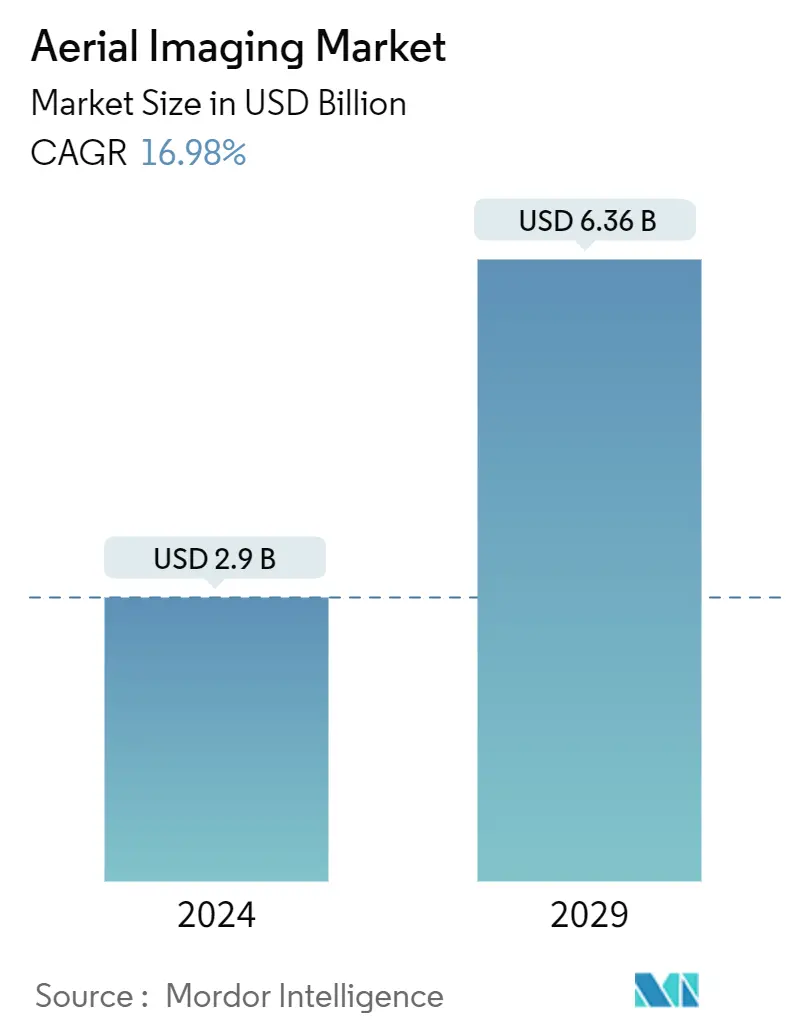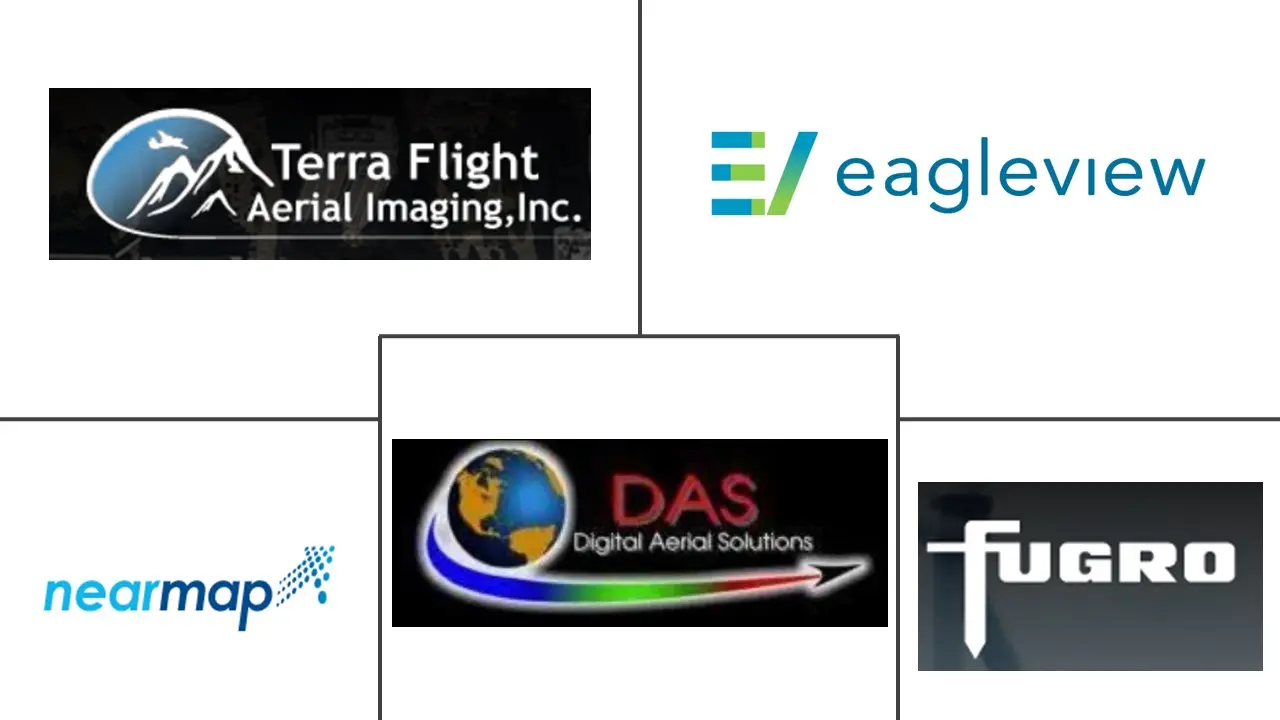Market Size of Aerial Imaging Industry

| Study Period | 2019 - 2029 |
| Market Size (2024) | USD 2.9 Billion |
| Market Size (2029) | USD 6.36 Billion |
| CAGR (2024 - 2029) | 16.98 % |
| Fastest Growing Market | Asia Pacific |
| Largest Market | North America |
Major Players
*Disclaimer: Major Players sorted in no particular order |
Aerial Imaging Market Analysis
The Aerial Imaging Market size is estimated at USD 2.9 billion in 2024, and is expected to reach USD 6.36 billion by 2029, growing at a CAGR of 16.98% during the forecast period (2024-2029).
Aerial imaging and its evolution into video imagery have been captured using various small aerial platforms for over three decades. Small-scale platforms such as radio-controlled model aircraft, helicopters that use small 35 mm SLR, and light-weighted video cameras have been used to acquire color, panchromatic, color infrared (CIR), and multispectral aerial photography for a wide range of applications.
• The market has been augmented by the technology development of ready-to-fly (RTF) devices, soft-copy photogrammetry software, low-cost digital cameras, image processing, GPS, thermal, multispectral, hyperspectral, and LiDAR sensors. UAVs have become a sophisticated means of acquiring high-resolution photographic and 4K video datasets for small-area coverage studies.
• Aerial imaging uses GPS, which aids in precise location. For instance, farmers use GPS targeting to monitor the health of the crops, identify problem areas, and spray fertilizer. Energy and power site management benefits from the precision of aerial imaging, as it can be repaired from weather damages and targeted more accurately.
• Police departments also use maps that are being created using aerial imagery. The department uses it for the movement of essential items, placing physical distancing markers, workforce allocation, deciding where to set up isolation centers, marking nearby hospitals and police stations from hotspots, and the shortest routes for easy movement in an emergency.
• The COVID-19 pandemic has led to increased demand for aerial imagery. This imagery is used to study the virus's economic impact and remotely monitor infrastructure and facilities. The demand increased from various industries, including government, energy, power, oil, and gas. Also, the imagery monitored supply chain situations during the pandemic's peak.
• Although the trend of drone surveying is already becoming mainstream, the pandemic tipped the scale in its favor substantially. UAVs have become a go-to technology during the COVID-19 pandemic because they can accomplish tasks without contact. They have played a crucial role in surveying and mapping areas where hospitals and COVID-19 test centers can be built and monitoring such sites.
Aerial Imaging Industry Segmentation
Aerial photography is mainly used for geospatial mapping, media and entertainment, environmental studies, and other areas. It involves taking pictures of a flying object or aircraft. The various platforms for aerial photography include helicopters, UAVs/drones, balloons, blimps, rockets, kites, parachutes, airships, or any flying aircraft. The study tracks the revenue accrued from the different application types used across industries, such as government, aerospace, construction, and agriculture, among others worldwide.
The aerial imaging market is segmented by platform type (fixed-wing aircraft, helicopters, UAVs/drones), application (geospatial mapping, infrastructure planning, asset inventory management, environmental monitoring, national and urban mapping, surveillance and monitoring, disaster management), end-user industry (construction, aerospace and defense, government, oil and gas, energy and power, agriculture), by geography (North America, Europe, Asia-Pacific, Rest of the World). The market sizes and forecasts are provided in terms of value (USD) for all the segments.
| By Platform Type | |
| Fixed-wing Aircraft | |
| Helicopters | |
| UAVs/Drones | |
| Other Platform Types |
| By Application | |
| Geospatial Mapping | |
| Infrastructure Planning | |
| Asset Inventory Management | |
| Environmental Monitoring | |
| National and Urban Mapping | |
| Surveillance and Monitoring | |
| Disaster Management | |
| Other Applications |
| By End-user Industry | |
| Construction | |
| Aerospace and Defense | |
| Government | |
| Oil and Gas | |
| Energy and Power | |
| Agriculture | |
| Other End-user Industries |
| By Geography | |
| North America | |
| Europe | |
| Asia-Pacific | |
| Rest of the World |
Aerial Imaging Market Size Summary
The aerial imaging market is experiencing significant growth, driven by advancements in technology and increasing applications across various sectors. Over the past three decades, aerial imaging has evolved from basic photography using small-scale platforms to sophisticated systems incorporating UAVs, GPS, and advanced sensors like LiDAR and multispectral cameras. This evolution has enabled high-resolution data collection for diverse applications, including agriculture, energy, and urban planning. The COVID-19 pandemic further accelerated the adoption of aerial imaging, as it provided contactless solutions for monitoring infrastructure and managing public health responses. The technology's ability to offer precise location data has made it invaluable for government planning, environmental studies, and disaster management, among other uses.
North America stands out as a major hub for aerial imaging due to its robust research and development activities and the high adoption rate of these technologies across various industries. The region's market growth is fueled by the increasing use of aerial imaging in construction, agriculture, and urban development, supported by government initiatives and infrastructure investments. The market is characterized by a fragmented landscape with numerous players, including Terra Flight Aerial Imaging Inc., Fugro Ltd, and Nearmap Ltd, actively exploring new opportunities. Recent developments, such as the creation of Ondas Autonomous Systems and strategic acquisitions like Bowman Consulting Group Ltd's acquisition of Surdex Corporation, highlight the industry's dynamic nature and the ongoing integration of advanced technologies to enhance aerial imaging capabilities.
Aerial Imaging Market Size - Table of Contents
-
1. MARKET INSIGHTS
-
1.1 Market Overview
-
1.2 Industry Value Chain Analysis
-
1.3 Industry Attractiveness - Porter's Five Forces Analysis
-
1.3.1 Bargaining Power of Suppliers
-
1.3.2 Bargaining Power of Buyers
-
1.3.3 Threat of New Entrants
-
1.3.4 Threat of Substitute Products
-
1.3.5 Intensity of Competitive Rivalry
-
-
1.4 Assessment of Impact of COVID-19 on the Industry
-
-
2. MARKET SEGMENTATION
-
2.1 By Platform Type
-
2.1.1 Fixed-wing Aircraft
-
2.1.2 Helicopters
-
2.1.3 UAVs/Drones
-
2.1.4 Other Platform Types
-
-
2.2 By Application
-
2.2.1 Geospatial Mapping
-
2.2.2 Infrastructure Planning
-
2.2.3 Asset Inventory Management
-
2.2.4 Environmental Monitoring
-
2.2.5 National and Urban Mapping
-
2.2.6 Surveillance and Monitoring
-
2.2.7 Disaster Management
-
2.2.8 Other Applications
-
-
2.3 By End-user Industry
-
2.3.1 Construction
-
2.3.2 Aerospace and Defense
-
2.3.3 Government
-
2.3.4 Oil and Gas
-
2.3.5 Energy and Power
-
2.3.6 Agriculture
-
2.3.7 Other End-user Industries
-
-
2.4 By Geography
-
2.4.1 North America
-
2.4.2 Europe
-
2.4.3 Asia-Pacific
-
2.4.4 Rest of the World
-
-
Aerial Imaging Market Size FAQs
How big is the Aerial Imaging Market?
The Aerial Imaging Market size is expected to reach USD 2.9 billion in 2024 and grow at a CAGR of 16.98% to reach USD 6.36 billion by 2029.
What is the current Aerial Imaging Market size?
In 2024, the Aerial Imaging Market size is expected to reach USD 2.9 billion.

